The Giza Sphinx faces east, while the pyramids’ sides are aligned precisely in the cardinal directions. There is little doubt that the Sun or stars must have been used to align the Giza pyramids, but was there an actual use for the directions in which they were built? And what might we deduce from their specific alignment? This article argues that the directions these structures are aligned in may reveal that there are more hidden chambers inside the pyramids. What’s more, both the starry sky and Nile flood phenomenon may furthermore explain the Sphinx figure and its location.
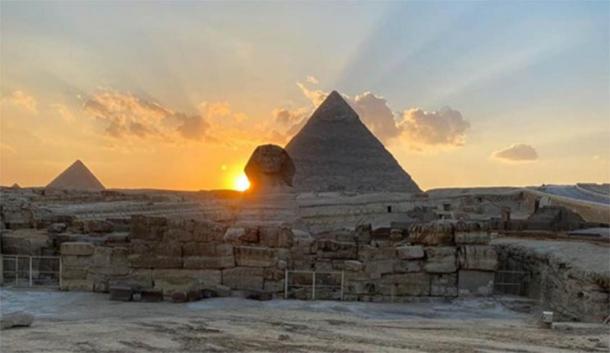
Egyptian Ministry of Antiquities photo showing the sun set along Khafre’s pyramid at equinox. ( Ministry of Antiquities )
An Ancient Origins article by Ed Whelan displayed a photo of the Sun setting behind the Sphinx’ shoulder at equinox . The article claims that this photo could revolutionize our understanding of the ancient structure. Reading this triggered a personal desire to find out more about directions at Giza. While it is true that the straight lines of the pyramids could be useful for determining astronomical events, such as equinoxes and more, I believed that the Sphinx itself wouldn’t be able to provide any good sight lines as it lies parallel to, but clearly off the sight line along the southern side of Khafre’s pyramid if you look at a map.
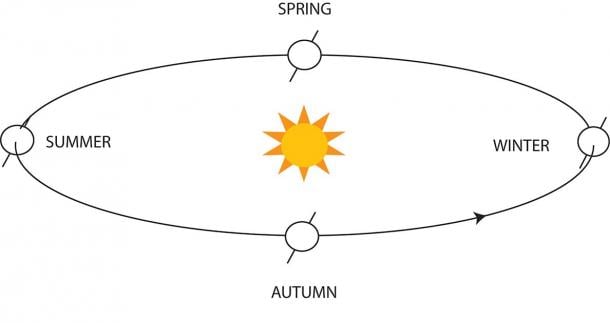
Earth’s axis is tilted 23.5 degrees, which gives us winter and summer. Shown here for the northern hemisphere. (Illustration by author)
Precise East-West Line of the Great Pyramid of Giza
The Pyramid of Khufu, another name for the Great Pyramid of Giza , was the first built at Giza. Pinpointing sunrise and sunset directions any day from a central spot with a length of rope would provide rather precise points for an east-west line, although the results would be best during the solstice. The very precise lines of Khufu’s pyramid really are remarkably accurate – just small fractions of one degree off the true directions. The rising and setting of a star could also have been used to the same effect.
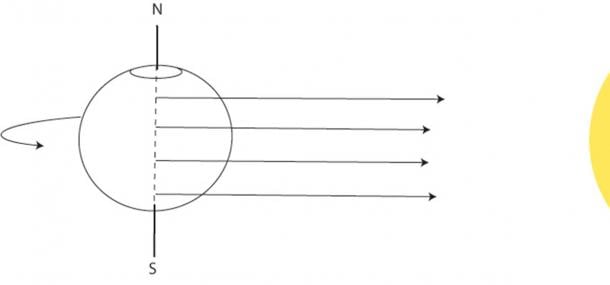
Sunrise line on the Earth at Autumn Equinox (imagine the Earth is tilting towards you). The Sun rises due east no matter the latitude. Sunset is due west at the same time on the opposite side of Earth. (Illustration by author)
Astronomical Importance of North and South
Many of us know how to find north at night by looking at the starry sky. The pyramids were also aligned using the stars around the North Pole. South is also a good direction astronomically. It is valuable for seeing when, at night, different stars or planets cross the due south line (the Meridian). Just think of the Sun. How do you figure out where the Sun is in the starry sky? When the Sun is up, you cannot see the stars behind it. But if you observe which stars are due south at midnight, you also know that the Sun must be in the exact opposite direction. If you know your sky, you know where that is. Of course this reasoning presupposes an idea of a circular movement that also applies to night hours.
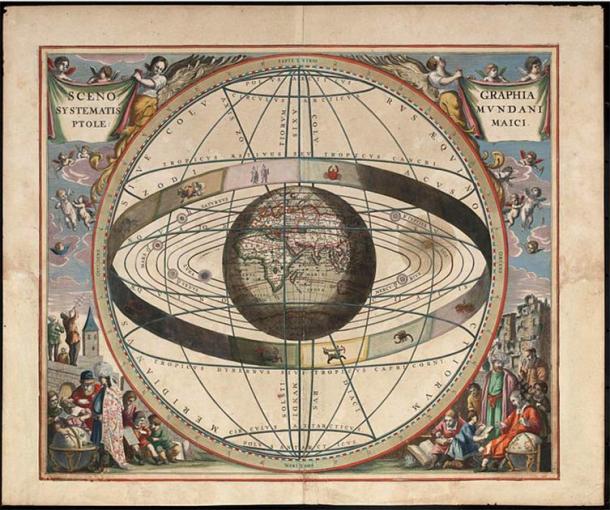
Andreas Cellarius illustration from 1660 showing the belt of the Zodiac. ( Public domain )
The Zodiac and the Decans
The Earth is surrounded by stars in all directions. If you imagine the stars as fixed to a giant sphere, this is similar to the vision which Europeans of antiquity and the Middle Ages believed in. All the Sun’s planets, including the Earth and its moon, have orbits around the Sun more or less in the same plane. This causes the Sun, the Moon and planets, when observed from Earth, to appear to have a band or sphere of stars in the background: the Zodiac.
Think of the Sun’s daily route, as this gives you a good idea of which part of the sky that is. This band likewise seems to rotate, with the southern half of the band above the horizon, while the northern half is below the horizon (due to the Earth tilting). The two halves meet at the horizons in east and west. At Giza (latitude 30°N), the band rises higher on the southern sky than in central or northern Europe.
Possibly already during Khufu’s time, the Egyptians had divided the belt of stars into 36 decans, each covering a 10 day passing of the Sun – a 10-day week. They added five days in the end of the year to give the year 365 days (but they missed the extra day every fourth year). It is questionable, but not impossible, that they were familiar with some of the later zodiacal signs in Khufu’s days.
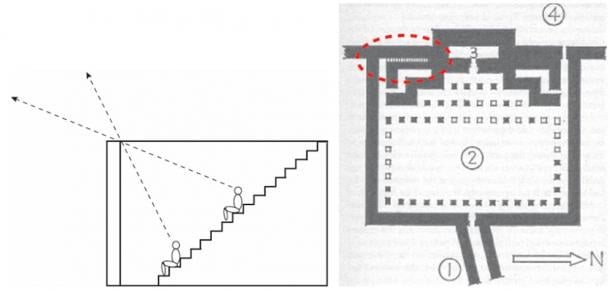
The narrow north-south staircase in Khufu’s mortuary temple along the eastern wall of his pyramid complex would provide excellent observation posts for star or planet passages. The temple roof gave sky overview and the (un-roofed) staircase precision. (Illustrations by author and from IES Edwards: The Pyramids of Egypt, 1947)
A Staircase Observatory?
Earth fulfills one full rotation in twenty-four hours. Viewed from the ground we experience this as the Sun circling around Earth once in a day and a night. The same goes for all the stars of the Zodiac, the decans, and the Moon and planets too.
The Meridian – the sight line due south from horizon and upwards – is, as mentioned, most practical for keeping record of the Sun’s position. It is also very useful, if you wish to precisely measure the slow changes in planet positions in the signs of the Zodiac or decans. Or basically record distances between stars to produce a star map.
At Giza they could use the side of a pyramid to aim due south and a vertical hanging wire to mark the Meridian in front of them. But frankly it seems inelegant to have to lean on a slanting side of a pyramid while observing the passage of stars and planets. Instead, for example, the narrow south-north staircase leading to the roof of Khufu’s mortuary temple seems a smarter observation post, if un-roofed (see illustration above).
Even though the sight line wouldn’t be directly along a side of a pyramid, the wall surrounding it would run parallel to the pyramid’s sides. The narrow walls on both sides of the staircase would nicely frame the south direction – a stick or cord in the middle would help narrow the precision (come to think of it: If they used this method, the different steps which were used as posts in a way actually expressed different latitudes of observed stars).
Time measuring is important to record precise passage of hours, because time gone equals distance. The water clock, a bowl with a small hole near the bottom and hours marked inside, is said to be a later invention. Either they had invented a good time measurement method already then, or they weren’t able to get the best out of the precise sight line they had. Instead they may just have referred the planet positions to the decans, which were used as night-hour counters (the night hour numbers confusingly shifting one decan every 10 nights, matching the opposite movement of the Sun). This way of recording planet positions would not match the precision of the pyramid.
Anyway, they would only need one good sight line north-south for observation purposes, so when all the pyramids at Giza are aligned in the cardinal directions, maybe we should look into possible symbolism of these directions?
Symbolism of Directions in the Pyramids
There is one obvious daily life symbolism, which is inevitable to notice: Nature gifted Egypt with two dominating life-sustaining forces: the Sun and the Nile. Together they formed the base for Egypt’s early civilization. The Sun was sailing from east to west up in the sky , and the Nile was flowing from south to north down on the ground . Can these both be related to the pyramids’ orientation?
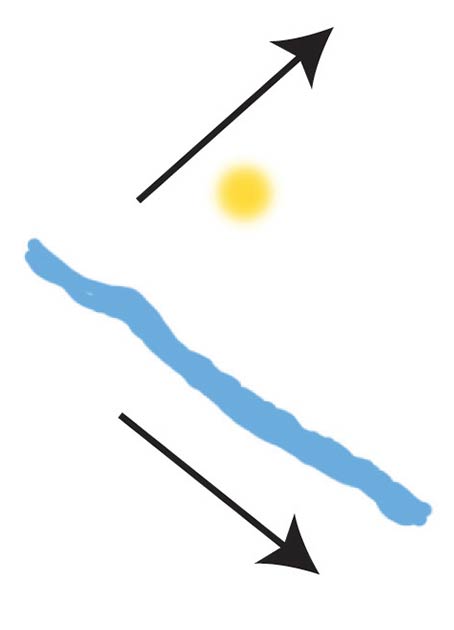
High and low directions of sun (east-west) and Nile (south-north). (Illustration by author)
Corridors in some of the pyramids run parallel to their sides straight in the cardinal directions. It can be productive to consider the symbolism of the pyramids’ inner architecture as reflecting the outer world, including the directions of the Sun and the Nile. If you already accept that the east-west direction refers to the Sun, it is not that unlikely that the south-north direction refers to the Nile besides any nightly astronomical importance.
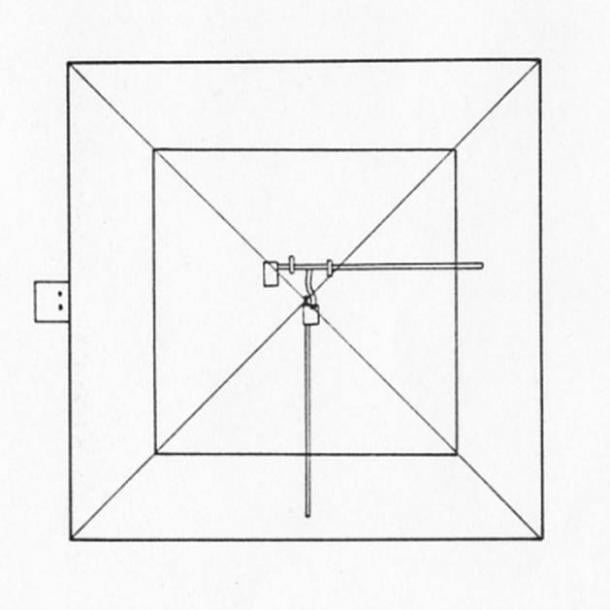
The Bent Pyramid at Dashur (one of the two or three pyramids which Khufu’s father built) has two entrances, the corridors leading from north (bottom of drawing) due south, and from west (right) leading due east. Notice that the upper chamber lies south-east of the center in this pyramid. (Rainer Stadelmann / Die Ägyptischen Pyramiden)
Khufu’s Father’s Most Interesting Pyramid
The Bent Pyramid of pharaoh Sneferu, the father of Khufu, includes two corridors: a lower leading from north strictly southwards, as is normal in pyramids, but also a corridor leading from west strictly eastwards at a higher level. This corridor was discovered from the inside out through a narrow ancient dug tunnel. The two corridors were apparently not planned to demonstrate in architecture that they were connected.
With equal right, the corridors can be regarded as following the Nile’s and the Sun’s moving directions leading out of the pyramid, as leading the opposite directions in, for priests humbly approaching the sacred shrines/chambers.
The north-south corridor leads to the lower chambers (representing the king’s body or life on earth?), while the east-west corridor follows the Sun’s daily birth or sailing direction. This corridor leads to the highest situated chamber, which logically must represent the afterlife, where the king joins the sun god in his boat crossing the sky from east to west. Two blocking stones in this upper corridor frame the lower corridors and chambers, and could be understood as symbolically denoting birth and death of the king, the two portals of earthly life.
Such an interpretation of the interior chamber system offers a built-in illustration of an unrecognized, but logical, stairway to heaven. It also raises questions regarding the possibility of finding east-west corridors higher up in other pyramids with respect to the pyramids’ purpose of being a ladder, helping the spirit of the king climb up and join the sun in the sky. This would mean that there could be hidden chambers in several pyramids yet to discover!
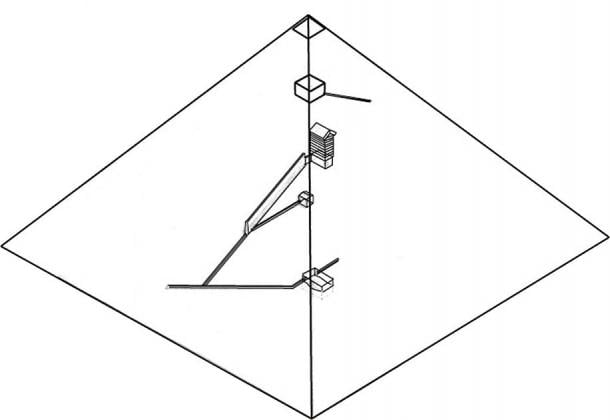
Proposed chamber system in Khufu’s pyramid (looking south-east) with a similar entrance high on the west side. (Illustration by author)
Khufu’s Undiscovered Chamber
I previously published a two-part series of articles on Ancient Origins : The Great Pyramid: New Theory on God Symbolism and the Hidden Chambers and Hidden Chamber and Meaning: Is the Great Pyramid for a King or Priests? In these, I argue for the existence of a similar higher west-east corridor in Khufu’s pyramid with an entrance on the west side, leading strictly eastwards to the sun god Ra-Atum’s unknown chamber (which I, unrelated to directions, had deduced the existence of). The known corridors lead in my understanding from the north entrance southwards to the three known chambers, honoring from bottom up the earthbound element-gods: the earth god Geb, the water goddess Tefnut, and the air god Shu, respectfully. Together with Ra-Atum and Nut, the starry sky (top chamber), these five gods were the first born gods in nearby Heliopolis’ creation story and therefore quite relevant at Giza.

Transparent plan of the chambers of Khufu’s pyramid. The supposed “sun’s chamber” (fat dotted line), completes the chamber layout having the well in the subterranean chamber as center point. Notice that the chamber system lies southeast from the center – and that the well is turned in the direction of the Sphinx. Only sky goddess Nut’s top chamber is bound to be directly under apex (not included). (Illustration by author)
Is “Southeast” Somehow Important?
Assuming this heaven and earth symbolism actually can be applied to some of the pyramids, there is more to learn about directions. In the Bent Pyramid the upper (sun’s) chamber lies southeast of the center. In Khufu’s pyramid, the chambers follow a system centered round the well in the subterranean chamber, which likewise is placed southeast of the pyramid’s center. The square well is even turned diagonally so as to underscore the southeast direction. If we follow the same line further out, we find the Sphinx.
My proposed location of an undiscovered chamber (the sun god’s chamber) is also centered over the well’s position, following and fulfilling a simple principle: each chamber points to a different cardinal direction (sun god’s eastwards, see drawing), and the sun’s chamber itself lies southeast of the center, like in Khufu’s father’s pyramid.
It has been noted that the south-east corners of all three major pyramids at Giza are aligned on a perpendicular north-east / south-west line. Some other pyramid complexes also have the southeast direction accentuated. This means that the southeast direction must generally have been important.
The turning of the well in the subterranean chamber, as well as the displacement of the chamber system in southeast direction, may indicate that Khufu’s pyramid (the first built at Giza) was placed to underscore the direction to the Sphinx, which was probably already there or was created at the same time.
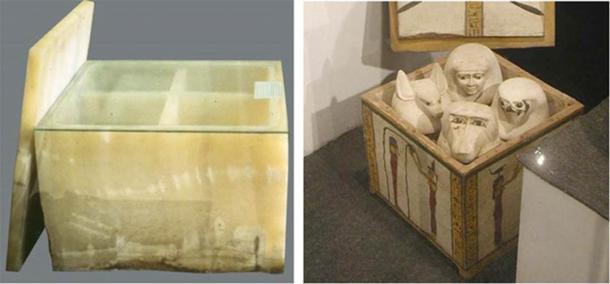
Left: The quadratic form of the shrine for the canopic jars might indicate that each son of Horus resided over a quadrant of directions. Canopic chest of Hetepheres, wife of Seneferu (Khufu’s father), Giza, 4 th dynasty. Egyptian Museum, Cairo. (Aidan Dodson / University of Bristol )Right: Jars with lids in the form of the sons of Horus .(Luxor Museum / Museum Syndicate )
Gods of Directions
In 1901, E.A. Wallis Budge wrote in Egyptian Magic about the four sons of Horus, who each protected a jar with organs of the deceased king:
“They played a very important part in the funeral works of the early dynasties; they originally represented the four supports of heaven, but very soon each was regarded as the god of one of the four quarters of the earth, and also of that quarter of the heavens which was above it.”
Now the interesting question is how “the four quarters of earth” and the sky above it is to be understood: each resided over one of the cardinal directions, but was the quarter measured 45° to each side of it, or was it measured from one cardinal direction to the next (a quadrant)? The quadratic canopic jar chests have the jars in corners, which might imply quadrants.
If this last way was the one, each god resided over a corner of a pyramid. The human-headed god Mehsta (Wallis Budge, others call him Imsety/Amset) would be the one residing over all directions from south to east, which would encompass all the chambers in Khufu’s pyramid, and further out the Sphinx. Could this mean that the Sphinx’ head could be Meshta / Imsety’s human head. But whose corpse is it then? East residing Jackal-headed Tuamutef (/Duamutef)? There is another possibility.

Egyptian god Hapi (left) pouring water from jars (Denderah temple, c. 50 BC), may be the origin of later illustrations of Aquarius (right) traditionally pouring water out of jars. Hapi wears the crown of upper Egypt in the image. He was believed to live in caves close to Aswan, in the region of the 1 st cataract where the waters of the Nile were supposed to spring from. (Left: Author provided. Right: Fromold Books )
Star Constellations and Sphinx
The images of the constellations of the Zodiac were, we are usually told, first defined in Mesopotamia or Babylon. If the star constellation of the big lion was a figure which the Egyptians recognized in the sky when the Sphinx was made, it could connect this figure with stars.
The opposite constellation, the one we today call Aquarius, is on the Dendera temple star map (presumably c. 50 BC) cut in the figure of Hapi, Egyptian god for the Nile’s annual flood. I wish both the lion and this Hapi star sign are elder. The implications are interesting.
As mentioned, the opposite constellation to Leo is Aquarius, or Hapi. In star-gazing terms, there is a connection between the two: as the sun set in the west, in the constellation of Leo, Hapi’s constellation rose in the east. During the night the sun traveled through the underworld, while Hapi crossed the sky from east to its highest peak in south at midnight, and then finally set in the west as the lion sun rose in the east for another fine day. Could this explain the collaboration of Leo and Hapi being expressed in a statue like the Sphinx?
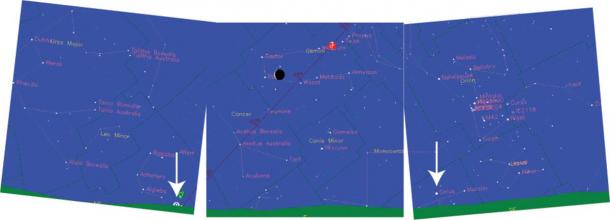
Computer calculation of sunrise at Giza 2550 BC, approximately at the day of Sirius’ heliacal rise, with the sun in Leo (mirrored question mark) rising below the left arrow. Sirius/Sothis/Sobdet is below the right arrow. ( Public Domain )
Heliacal Rise of Sirius (Sothis)
During the daytime, it is impossible to see the stars in the sky. The sun moves east 1° a day, so looking at the eastern horizon just before sunrise, the Zodiac / decans and other stars appear day by day the opposite way at the same speed as the Sun leaves them: 1° a day. The day the bright star Sirius (Sothis/Sobdet) reappeared after having been invisible was seen as a sign of the beginning of the annual flood of the Nile waters.
With the help of a computer program, I have pinpointed the Sirius heliacal rise at the time of Khufu. The hour is just at sunrise to show the Sun’s summer position north of east at sunrise. Sirius is visible above the horizon south of east. It doesn’t rise at the full 45° of south-east, but c. 27-28° south of east. So Sirius lies within the quarter of Meshta/Imsety, but is too far off south-east to claim Sirius the intended target for south-east importance, if we demand precision.
With no lines pointing clearly to Sirius, practical calendar use of the pyramids’ sight lines would therefore have been limited to equinoxes, without leaving traces of that to history other than the pyramids themselves and their sight lines.
Nevertheless, this day of Sirius’ heliacal rise the Sun is in the Leo Constellation (the mirrored “question mark”), so the above mentioned collaboration between the constellations Leo and Hapi is nicely bound to the beginning of the Nile’s flood. So in the end the Sphinx, even with no clear sight lines, may be the one most obviously linked to both the Sun and stars.
Ancient Origins Tours will be investigating the Qasr el-Sagha temple, the Egyptian Labyrinth, and Amenemhat III’s pyramid at Hawara as part of a very special expedition in Egypt in September 2021. Why not join us for this unique experience that will bring you closer than ever before to Egypt’s first female ruler, whose story is now being told for the first time. The trip will include writer and author Andrew Collins, who will be speaking extensively about Sobekneferu and her world.
For more information on Ancient Origins Egypt Tour click here .

Top image: What secrets could the alignment of the Giza Sphinx and the Great Pyramid of Giza be hiding? Could there be further hidden pyramid chambers inside the Great Pyramid? Source: Aliaksei / Adobe Stock
